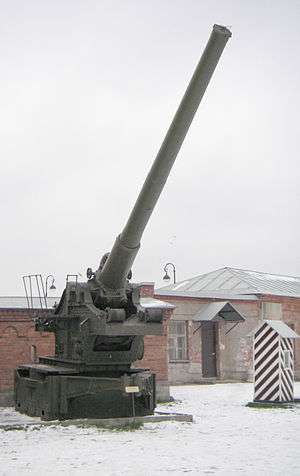210 mm gun M1939 (Br-17)
| 210 mm gun M1939 (Br-17) | |
|---|---|
|
Br-17 in Saint Petersburg Artillery Museum. | |
| Type | heavy siege gun |
| Place of origin | Czechoslovakia |
| Service history | |
| Used by |
|
| Wars | World War II |
| Production history | |
| Designer | Škoda |
| Manufacturer | Škoda |
| Produced | 1940-1941 |
| Specifications | |
| Weight | 43,218 kg (95,279 lb) |
| Barrel length | 10.058 m (30 ft) |
|
| |
| Shell | 134.8 kg (297 lb) |
| Caliber | 210 millimetres (8.3 in) |
| Elevation | -6° to +50° |
| Traverse | 22° |
| Rate of fire | 1 round per 3 minutes |
| Muzzle velocity | 800 m/s (2,600 ft/s) |
| Maximum firing range | 29.36 km (18.24 mi) |
The 210 mm gun M1939 (Br-17) (Russian: 210-мм пушка образца 1939 года (Бр-17)) was a Czechoslovak heavy siege gun used by the Soviet Union during World War II. After the Germans occupied Czechoslovakia in March 1939 they took over the Škoda Works, which had been working on this design and a companion 305 mm howitzer. As a result of the Molotov-Ribbentrop Pact the Germans sold both designs to the Soviet Union. It's not entirely clear that Škoda actually built the weapons itself or merely supplied the blueprints. At any rate, very few weapons seem to have built, so much so that there's no record of the Germans capturing any after Operation Barbarossa.
It used the same carriage as 305 mm howitzer M1939 (Br-18) as well as the same firing platform and control mechanism. It was transported in three loads.
See also
References
![]() Media related to 210-mm gun M1939 (Br-17) at Wikimedia Commons
Media related to 210-mm gun M1939 (Br-17) at Wikimedia Commons
- Chamberlain, Peter & Gander, Terry. Heavy Artillery. New York: Arco, 1975 ISBN 0-668-03898-5

